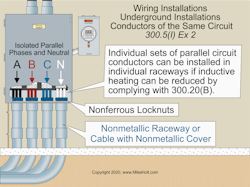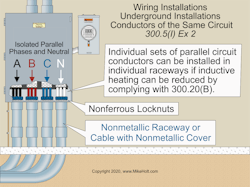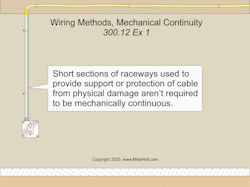Article 300 of the National Electrical Code (NEC) contains the general requirements for wiring methods and materials for power and lighting [Sec. 300.1(A)]. It includes the general requirements for all wiring methods included in the NEC but does not apply to twisted-pair cable and coaxial cable (covered in Chapters 7 and 8) unless Art. 300 is specifically referenced. Nor does it apply to the integral parts of electrical equipment [Sec. 300.1(B)]; such equipment is covered by various product standards [Sec. 90.7].
Conductors
Conductors must be installed in a Chapter 3 wiring method such as in a raceway, cable, or enclosure [Sec. 300.3(A)]. Table 300.1(C) provides the designators for raceway trade sizes.
All conductors of a circuit (including the neutral and equipment grounding conductors) must be run in the same raceway, cable, trench, cord, or cable tray except as permitted by Sec. 300.3(B)(1) through (4). For example, if you run conductors in parallel per Sec. 300.10(G), this requirement applies separately to each run [Sec. 300.3(B)(1)].
Connections, taps, or extensions made from paralleled conductors must connect to all conductors of the paralleled set. Exception: Parallel phase and neutral conductors can be installed in individual underground nonmetallic raceways (Phase A in raceway 1, Phase B in raceway 2, etc.) as permitted by Sec. 300.5(I) Exception No. 2 if the installation complies with Sec. 300.20(B).
Power conductors rated 1,000V or less can occupy the same raceway, cable, or enclosure if all conductors have an insulation voltage rating of at least that of the maximum circuit voltage [Sec. 300.3(C)(1)]. But control, signaling, and communications wiring must be separated from power and lighting circuits so the higher-voltage conductors do not accidentally energize the control, signaling, or communications wiring.
Where subject to physical damage, conductors, raceways, and cables must be protected [Sec. 300.4]. This principle is repeated throughout the NEC. For example, Sec. 300.4 is followed by a long enumeration of specifics in Sec. 300.4(A) through (H). The particulars of running nonmetallic cable through bored holes in wood frame members [Sec. 300.4(A)] certainly won’t apply to process heating equipment [Art. 425]. That said, you will find many of these instances to be nearly verbatim to Sec. 425.12(A): “Where subject to physical damage, fixed industrial process heating equipment shall be protected in an approved manner.”
When cables or raceways are installed underground, they must have a minimum cover per Table 300.5 [Sec. 300.5(A)]. Cables and insulated conductors installed in underground enclosures or raceways must be listed as suitable for a wet location [Sec. 310.10(C)].
Cables and conductors installed under a building must be within a raceway that extends past the outside walls of the building [Sec. 300.5(C)]. Exception No. 2: Type MC Cable listed for direct burial or concrete encasement is permitted under a building without installation within a raceway [Sec. 330.10(A)(5) and Sec. 330.10(A)(11)].
Direct-buried conductors and cables, such as Types MC, UF, and USE installed underground, must be protected from damage per Sec. 300.5(D) (1) through (4). For example, underground conductors and cables that enter a building must be protected to the point of entrance.
Direct-buried conductors or cables can be spliced or tapped underground without a splice box [Sec. 300.15(G)] if the splice or tap is made per Sec. 110.14(B) [Sec. 300.5(E)].
Backfill material for underground wiring must not damage underground raceways, cables, or conductors [Sec. 300.5(F)]. Large rocks, chunks of concrete, steel rods, mesh, and other sharp-edged objects can damage the underground conductors, cables, or raceways, so don’t use them in backfill.
If moisture could contact energized live parts through an underground raceway, a seal identified for use with the cable or conductor insulation must be installed at either or both ends of the raceway [Sec. 300.5(G)]. Raceways that terminate underground must have a bushing or fitting at the end of the raceway to protect emerging cables or conductors [Sec. 300.5(H)].
Underground conductors of the same circuit (including the equipment grounding conductor) must be installed inside the same raceway or multiconductor cable, or be near each other in the same trench [Sec. 300.5(I)]. See Sec. 300.3(B).
Exception No. 2: Underground parallel conductors can have the conductors of each phase or neutral in separate nonmetallic raceways where inductive heating at raceway terminations is reduced by the use of aluminum locknuts and by cutting a slot between the individual holes through which the conductors pass as required by Sec. 300.20(B) and shown in Fig. 1 below.
Raceways
If a raceway is subjected to different temperatures — and where condensation is a known problem — the raceway must be filled with a material (approved by the authority having jurisdiction) that will prevent the circulation of warm air to a colder section of the raceway.
Sealants must be identified for use with cable insulation, conductor insulation, a bare conductor, a shield, or other components [Sec. 300.7(A)]. One common product used for this is electrical duct seal, and it is so identified. Typical expanding foams used to seal buildings are not identified for this application.
Raceways must be provided with expansion, expansion-deflection, or deflection fittings (where necessary)to compensate for thermal expansion, deflection, and contraction [Sec. 300.7(B)].
Note: Table 352.44 provides the expansion characteristics for PVC conduit. The expansion characteristics for steel conduit are determined by multiplying the values from Table 352.44 by 0.20. Those for aluminum raceways are determined by multiplying the values from Table 352.44 by 0.40. Table 355.44 provides the expansion characteristics for reinforced thermosetting resin conduit (RTRC).
The interior of raceways installed in wet locations above ground is considered a wet location. Insulated conductors and cables installed in raceways in aboveground wet locations must be listed for use in wet locations per Sec. 310.10(C) [Sec. 300.9]. In addition to Sec. 310.10(C), Table 310.4(A) can be used to find other insulation types permitted in wet locations.
Metal raceways, cable armor, and other metal enclosures must be metallically joined into a continuous electrical conductor to provide effective electrical continuity [Sec. 300.10]
Exception No. 1: Short lengths of metal raceways used for the support or protection of cables are not required to be electrically continuous, nor are they required to be connected to an equipment grounding conductor [Sec. 250.86 Exception No. 2 and Sec. 300.12 Exception No. 1].
The purpose of electrical continuity between metal parts is to establish the effective ground-fault current path necessary to operate the circuit overcurrent protective device in the event of a ground fault [Sec. 250.4(A)(5)].
Raceways, cable assemblies, and enclosures must be securely fastened in place [Sec. 300.11(A)]. You can’t use ceiling-support wires or the ceiling grid to support raceways or cables [Sec. 300.11(B)]. Independent support wires secured at both ends can be used to support raceways or cables.
Electrical wiring within the cavity of a fire-rated ceiling assembly can be supported by independent support wires attached to the ceiling assembly. The independent support wires must be distinguishable from the suspended-ceiling support wires by color, tagging, or other effective means [Sec. 300.11(B)(1)].
Outlet boxes [Sec. 314.23(D)] and luminaires can be secured to the suspended-ceiling grid if the luminaire is securely fastened to the ceiling-framing members by mechanical means, such as bolts, screws, or rivets, or by the use of clips or other securing means identified for use with the type of ceiling-framing member(s) used [Sec. 410.36(B)].
Cables cannot support other wiring methods [Sec. 300.11(D), but a raceway can if the raceway:
- Is identified as a means of support [Sec. 300.11(C)(1)].
- Supports Class 2 and 3 cables and supplies power to the equipment controlled by the Class 2 or 3 circuits [Sec. 300.11)(C)(2)].
Supports boxes or conduit bodies per Sec. 314.23 or luminaires per Sec. 410.36(E) [Sec. 300.11)(C)(3)].
Raceways and cable sheaths must be mechanically continuous between boxes, cabinets, and fittings [Sec. 300.12].
- Exception No. 1: Short sections of raceways used to provide support or protection of cables from physical damage are not required to be mechanically continuous [Sec. 250.86 Exception No. 2 and Sec. 300.10 Exception No. 1], as shown in Fig. 2 below.
- Exception No. 2: Raceways and cables installed into the bottom of open-bottom equipment, such as switchboards, motor control centers, and floor or pad-mounted transformers, are not required to be mechanically secured to the equipment.
Understanding is evident
Article 300 is primarily concerned with how to install, route, splice, protect, and secure conductors and raceways. How well you understand and apply the requirements of this Article will usually be evident in the finished work. Many of its requirements affect the appearance and longevity of the installation.
These materials are provided by Mike Holt Enterprises in Leesburg, Fla. To view Code training materials offered by this company, visit www.mikeholt.com/code.
About the Author

Mike Holt
Mike Holt is the owner of Mike Holt Enterprises (www.MikeHolt.com), one of the largest electrical publishers in the United States. He earned a master's degree in the Business Administration Program (MBA) from the University of Miami. He earned his reputation as a National Electrical Code (NEC) expert by working his way up through the electrical trade. Formally a construction editor for two different trade publications, Mike started his career as an apprentice electrician and eventually became a master electrician, an electrical inspector, a contractor, and an educator. Mike has taught more than 1,000 classes on 30 different electrical-related subjects — ranging from alarm installations to exam preparation and voltage drop calculations. He continues to produce seminars, videos, books, and online training for the trade as well as contribute monthly Code content to EC&M magazine.



